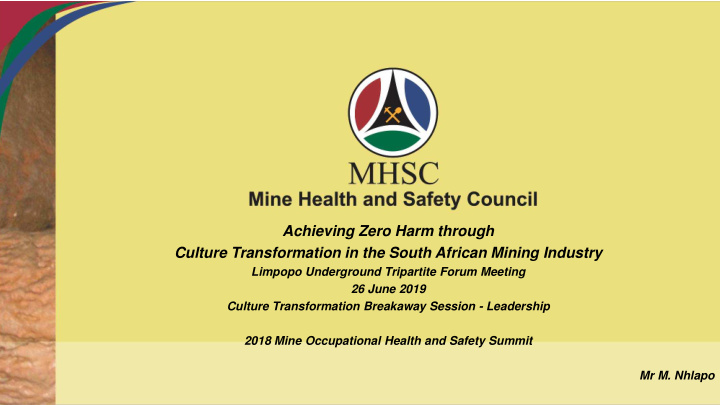



Achieving Zero Harm through Culture Transformation in the South African Mining Industry Limpopo Underground Tripartite Forum Meeting 26 June 2019 Culture Transformation Breakaway Session - Leadership 2018 Mine Occupational Health and Safety Summit Mr M. Nhlapo
BACKGROUND • Leaders are not borne but become skilled through being developed. • Leadership cuts across broader stakeholders (Union; Management & the State). • Zero Harm was defined, and must include: • No injuries and diseases everyday at the workplace. • Wellness programmes in place. • How do we translate zero harm as leaders – demonstrated leadership.
Leadership The facilitator allowed a flow of discussions, having initially posed a question: Are leaders undertaken through a vigorous development programme and if not what needs to be done? Recommendation: RTF`s must engage on the CTF Pillars: Dr Phakathi and Mr. Mziwakhe invited in Limpopo and Mpumalanga.
Current situations 1. Momentum for transformation has been lost. 2. Transformation actions are compliance based 3. Leaders expect things to happen without being explicit and transparent about what they want. 4. Leaders are not trained to make decisions around technology. 5. Historically, mining does not have a culture of executive liability.
Current situations 8. Reactive approach to health and safety, not proactive 9. Leaders are not transformed and hence subordinates cannot be transformed 10. Language used in terms of leadership absolves workers of the responsibility of their own safety as they don’t see themselves as leaders. 11. Are we reducing the risk? A state of complacency! 12. Leaders must address victimisation and discrimination. 13. Trade unions relations. 14. Leaders must define who they are and what they stand for. 15. Trade unions differences – a need to collaborate for the interest of workers.
Recommendations 1. Move to a point where people understand transformation as business imperative, not for compliance 2. Leaders must put an effort to commit to transformative actions 3. A mindset shift for leaders at all levels for all stakeholders. 4. Equip leaders to understand the implications of technology decisions in making the working environment safer and healthier
Recommendations 6. Change the culture on accountability 7. People should be made to feel as though they are part of the change. Culture of collective decision making must be created 8. Supervisors must give confidence to those below 9. Employees should be seen as leaders in charge of their own health and safety. 10. Demonstrated Commitment – Unions will work together in the best interest of the workers. 11. Define: • SAMI leadership characteristics – skills set required. • Behavioural traits we want to see as the leader.
Recommendations 12. MHSC to work with MQA to develop a programme to enhance the skills set identified for the SAMI. 13. RTF`s must engage on the CTF Pillars: Dr. Phakathi and Mr. Mziwakhe invited in Limpopo and Mpumalanga.
Conclusion The recommendations made on these crucial CTF Pillars, will form part of work programmes that will be developed for MHSC and other stakeholders, in order to accelerate the industry’s path to Zero Harm!!
EVERY MINE WORKER RETURNING FROM WORK UNHARMED EVERYDAY 20 Years of Positive Contribution to Zero Harm for mine workers. Pursuing Research Excellence
Recommend
More recommend